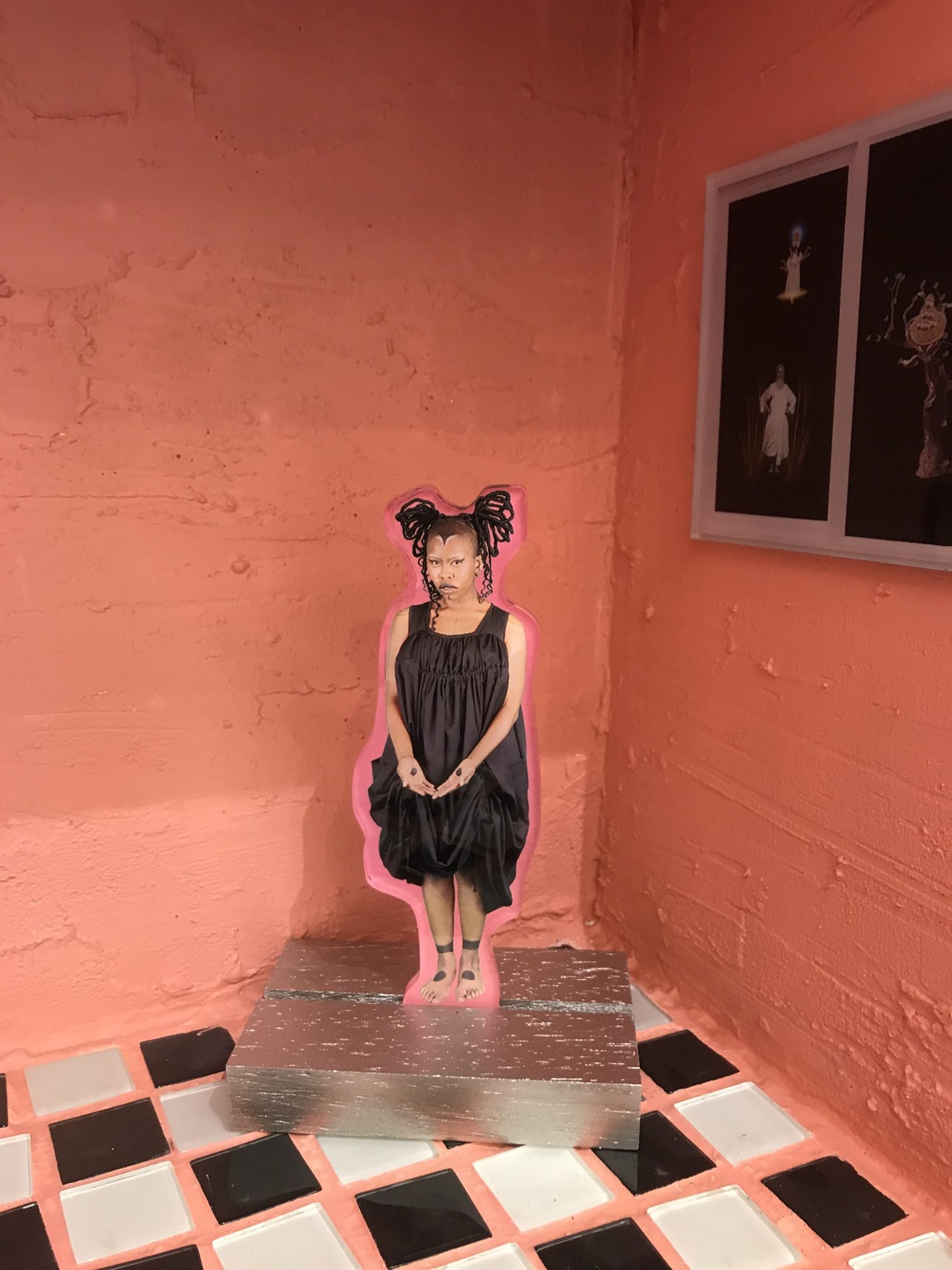Natalie Paneng’s Ke Thlogo (2023) installation stood out at the STEVENSON exhibition, I Miss Myself The Most. Paneng’s installation features a suspended chair with a miniature house, alongside a metaphorical Room Divider within a space reminiscent of familiar South African homes. With its cleverly kitsch aesthetic and irreverent play on scale, the installation subtly blurs the barrier between lived experience and absurdity.
Born in 1996, Paneng is a Jozi-based multidisciplinary artist who’s taken the South African art world by storm. She earned her BA in Dramatic Arts from the University of Witwatersrand and has since accumulated lucrative accolades like the Leon Gluckman Prize in 2018. Paneng has participated in various exhibitions including TMRW Gallery, The National Arts Festival, Blank Projects, BKHz Gallery and Javett Art UP, and several residencies like Bubblegumclub’s Future 76 Residency and Fak’ugesi Digital Innovation Artist Residency.
A feature in the prestigious STEVENSON is just another notch on this unstoppable artist’s trajectory. Known as a digital artist, Paneng proves her sculptural prowess with this immersive installation. “Ke Thlogo,” Setswana for “it’s a head,” evokes the lyrics of a childhood nursery rhyme. Paneng pounces on the politics of display by transforming a Room Divider into a self-portrait, adding feet, lips, and a septum-clad nose. Tiny photographic cutouts depicting the artist in the ‘head-shoulders-knees-and-toes’ configurations sit variously within the structure, energetically reminiscent of “The Written Woman” in Jodorowsky’s The Holy Mountain (1973).




Drawing from her theatre background, Paneng operates like a set designer, using a tactile approach to create forms that defy traditional spatial dynamics. Her playful juxtaposition of external and internal spaces, larger environments and miniature ones, her self-portraits, mosaics and mirrors, toy with themes of space, self, safety and home.
To the left of the room divider is a miniature version of Paneng’s any-house, inspired by her personal observations around South African neighbourhoods. The house facade with its loopy perspective evokes nostalgia for places “frozen in time”, with a video element peeking through the tiny house’s windows. This video, played through a smartphone, with the cable showing, bridges digital and physical realms, experimenting further with the notion of scale.
Traditionally, the objects curated onto room dividers, including cherished porcelain or silverware, adorn shelves with the prized objects reserved only for special guests. Paneng’s surrealist concoctions become details within an artistic framework that asks us whether we are the guests or the inhabitants. Mundane items become vessels for memory and motifs like house numbers, a ceramic dog, a chandelier and a checkered floor, symbolic exaltations of the bond between physicality and memory.



In this work, Paneng re-presents familiar forms and objects specifically from her grandmother’s hom, harnessing her heritage for something sacred. She notes that her grandmother’s daily interactions with these objects, make them cherished witnesses for familial connections. The artist is honouring these connections by challenging traditional notions of value and representation.
The installation’s shrine-like quality is influenced by the artist’s Christian background, which she says defined her childhood home’s aesthetic. While not explicitly religious, the work evokes themes of worship, spirituality, emotional grounding and “higher beings.” A Desiderata text modelled after one from her grandmother’s house is another example of an object found in many Black households and its influence on Paneng’s upbringing altered her worldview and thus her artistic practice.
The artist’s imprint is evident even on the very surface of her objects. Whether it is the tactility of the sculptural elements or the recognisability of her two-dimensional ones, the accessibility of her objects is almost perverse. The immediacy of Paneng’s artistic touch pierces through the rigid white cube space that is STEVENSON and intertwines intimate history with a space we can all connect to. Ke Thlogo almost instinctively elicits visceral and contemplative reflections on the passage of time within the contested terrain of domestic space.























































